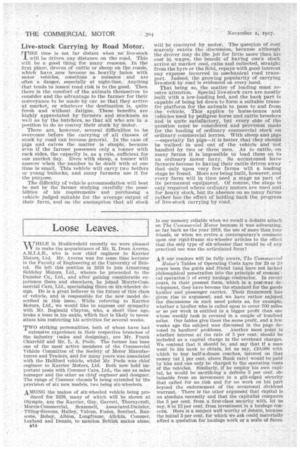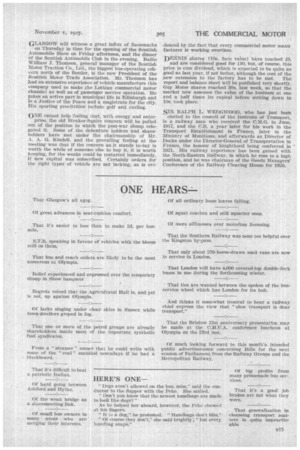Loose Leaves. -4 TfilLEinitd lers field recently were ileased IN tomaketieacjtaintanceotr Dean yes who
Page 32

Page 33

If you've noticed an error in this article please click here to report it so we can fix it.
is now chief engineer to Karrier Motors, Ltd. Mr. ..A.yerns was for some time lecturer in the Faculty of Engineering at the University of Bristol. He left this position in 1919 to join Armstrong Siddeley Motors, Ltd., whence he proceeded to the Daimler Co., Ltd., and after gaining considerable experience there and elsewhere, he joined Morris-Com-. mercial Cars, Ltd., specializing there on six-wheeler design. He is a great believer in the future of this class of vehicle, and is responsible for the new model described in this issue. While referring to Karrier Motors, Ltd., we would like to express our sympathy with Mr. Reginald Clayton, who, a short time ago, broke a bone in his ankle, lynch fact is likely to necessitate him restricting his activities for several weeks.
TWO striking personalities, both of whom have had extensive experience in their respective branches of the industry (sales and designing), are Mr. Frank Churchill and Mr. L. A. Poole. The former has been one of the most active members of the Commercial Vehicle Committee of the Society of Motor Manufacturers and Traders, and for many years was associated with the Hanford vehicle, whilst Mr. Poole was chief engineer to Karrier Motors, Ltd. .Both now hold important posts with Commer Cars, Ltd., the one as sales manager and the other as chief engineer and designer. The range of Commer chassis Is being extended by the provision of six new models, two being six-wheelers.
AMONG the 'makes of six-wheeled vehicle being produced for 1928, many of Which will be shown at Olympia, are the Karrier, Guy, Garrett, Thoruyetoft, Morris-Commercial, Scammell, Associated-Dainiler, Tilling-Stevens, Halley, Vulcan, Foden, Sentinel, Ransome, • Rebey, Albion, Longf tame, Alichin, Commer, Leyland and Dennis, to mention British makes alone. $14
Is our memory reliable when we recall a definite attack on The Commercial Motor because it was advocating, so far back as the year 1919, the use of more than tour 't-heels, or when we revive a contemporary's comment upon our rigid-frame six-wheeler articles to the effect that the only type of six-wheeler that would be of any practical use was the articulated form?
A S our readers will be fully aware, The Commercial Motor's Tables of Operating Costs have for 19 or 2o years been the guide mid friend (and have not lacked philosophical penetration into the principle of econonecal operation1) of every haulage contractor. In recent years, in their present form, which is a post-war development, they have become the standard for the goods haulier and passenger carrier. Their framework has given rise to argument, and we have rather enjoyed the discussions on such moot points as, for example, whether a haulier who is called upon to cover 700 miles or so per week is entitled to a bigger profit than one whose weekly task is covered in a couple of hundred miles.. Our tables give them the same profit, and a few weeks ago the subject was discussed in the page devoted to hauliers' problems. Another moot point is whether interest at the rate of 5 per cent. should be included as a capital charge in the overhead charges. We contend that it should be, and say that if a man went to his bank to obtain, lei us say, E10,000 with which to buy half-a-dozen coaches, interest on that money (at 1 per cent. above Bank rate) would be paid by him and can only be charged to the operating costs Of the vehicles. Similarly, if he employ his own Capital, he would be sacrificing a definite 5 per cent. obtainable from an investment in a gilt-edged sAcurity that called for no .riSk and for no work on his, part beyond the endorsement of the occasional dividend warrant. There is the other argument that capital is an absolute necessity and that the capitalist 0.ompares the 5 per cent, from a first-class security With, let us say; 8 to 15 per cent :from investment in haulage concern. Here is a subject well worthy of debate, because the initial 5 per cent. for which we ask could materially affect a quotation for haulage work or a scale of fares. GLASGOW will witness a great influx of Sassenachs on Thursday in time for the opening of the Scottish „Automobile Show on Friday afternoon, and the dinner Of the Scottish Automobile Club in the evening. Bailie William .1. Thomson, genera/ manager of the Scottish Motor Traction Co., Ltd., the biggest bus-operating coilCern north of the Border, is the new 'President of the Scottish Motor Trade Association. Mr. Thomson has had an extensive experience of vehicle manufacture (his company used to make the Lothian commercial motor chassis) as well as of passenger service operation. He takes an active part in municipal life in Edinburgh and )s a Justice of the Peace and a magistrate for the city. His sporting proclivities include golf and curling.
ONE cannot help feeling that, with energy and enter prise, the old Straker-Squire concern will be pulled out of the position to which the post-war slump relegated it. Some of the debenture holders and shareholders have met under the chairmanship of Mr. A. A. G. Kindell, and the prevailing feeling at the meeting was that if the concern as it stands to-day is worth the while of someone else to buy it, it is worth keeping, for the works could be restarted immediately, if new capital was subscribed. Certainly orders for the right types of vehicle are not lacking, as is evi deneed by the fact that every commercial motor mann facturer is working overtime.
DENNIS shares (1.0s. face value) have touched £9, and are considered good (Or £10, but, of course, this price is cum dividend, which is expected to be quite as good as last year, if not better, although the cost of the new extension to the factory has to be met. The report and balance sheet will be published very shortly. Guy Motor shares reached 30s. last week, so that the market now assesses the value of the business at one and a half times its capital before writing down to 10s. took place.
SIR RALPH L. WEDGWOOD, who has just been elected to the council of the institute of Transport, is a railway man who received the C.M.G. in June, 1917, and the C.B. a year later for his work in the Transport Establishment in France, later in the Ministry of Munitions, and afterwards as Director of Docks under the Director-General of Transportation in France, the honour of knighthood being conferred in 1921.. His railway experience has been gained with the North-Eastern Railway, in which he rose to a high position, and he was chairman of the Goods Managers' Conference of the Railway Clearing House for 1920.




































































































